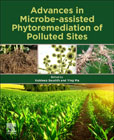
Advances in Microbe-assisted Phytoremediation of Polluted Sites
Bauddh, Kuldeep
Ma, Weiying
Advances in Microbe-assisted Phytoremediation of Polluted Sites provides a comprehensive overview of the use of phytoremediation to decontaminate polluted land through microbial enhanced phytoremediation, including the use of plants with respect to ecological and environmental science. The book discusses the potential of microbial-assisted phytoremediation of the contaminant, including heavy metals, pesticides, polyaromatic hydrocarbons, etc., with case studies as examples. Key subjects covered include plant-microbe interaction in contaminated ecosystems, microbe-augmented phytoremediation for improved ecosystem services, and success stories on microbe-assisted phytoremediation of contaminated sites. With increasing demand for land-space for social, industrial and agricultural use, the theoretical millions of hectares of contaminated sites around the world are a resource sorely needed that currently cannot be utilized. Decontamination of this land using ecologically-sound methods is paramount not only to land use, but in the prevention of toxic substances deteriorating local ecosystems by reducing productivity and contaminating the food chain - which can eventually aggregate in food chains and pose the potential risk of non-curable diseases to humans such as cancer. Provides novel information on the potential for microbial inoculants to be used in phytoremediation Discusses principles and mechanisms of plant-microbe interaction for enhanced phytoremediation with improved soil health Investigates phytoremediation solutions for a multitude of contaminants, including heavy metals, fly ash, petroleum, arsenic, TPH, mining effluents, fluoride, lead and other major pollutants INDICE: Theme 1: Overview of microbe-assisted phytoremediation 1. Microbe-assisted phytoremediation of environmental contaminants 2. Microbial augmented phytoremediation with improved ecosystems services 3. Role of genetic engineering in microbe-assisted phytoremediation of polluted sites in the era of climate change 4. Phytoremediation potential of genetically modified plants: a case study Theme 2: Microbe-assisted phytoremediation of inorganic contaminants 5. The role of plant growth-promoting bacteria in heavy metal bioaccumulation and biosorption 6. Plant-microbe association to improve phytoremediation of heavy metal 7. Bacterial mediated phytoremediation of heavy metals 8. Microbe-assisted phytostabilization of trace element contaminated sites 9. Phytoremediation of heavy metal contaminated soil in association of arbuscular mycorrhizal fungi 10. Role of Pb-Solubilizing bacteria in Pb uptake by plants 11. Role of Cd-resistant plant growth-promoting rhizobacteria in plant growth promotion and alleviation of the phytotoxic effects under Cd stress 12. Enhanced Phytoremediation by using plant growth promoting microbe for hexavalent chromium 13. Fluoride remediation through microbe-assisted phytoremediation technology 14. Toxic potential of As and its remediation through microbe-assisted phytoremediation 15. Phytoremediation of radionuclides with the help of beneficial microorganisms 16. Microbe-assisted phytoremediation of mine spoiled soils Theme 3: Microbe-assisted phytoremediation of organic contaminants 17. Rhizobacteria assist phytoremediation of oily-sludge-contaminated soil 18. Microbe-assisted phytoremediation of pesticides 19. In-field experiment for the identification of the best plant-soil microbiota combination for the removal of total petroleum hydrocarbons from contaminated soils 20. Using rhizosphere microorganisms for recovery of petroleum-contaminated soils 21. Association of plants and microorganisms for degradation of polycyclic aromatic hydrocarbons 22. Plant-endophyte partnerships to assist petroleum hydrocarbon remediation 23. The potential of engineered endophytic bacteria to improve phytoremediation of soluble organic pollutants: A case study
- ISBN: 978-0-12-823443-3
- Editorial: Elsevier
- Encuadernacion: Rústica
- Páginas: 426
- Fecha Publicación: 01/09/2022
- Nº Volúmenes: 1
- Idioma: Inglés
